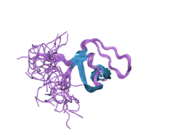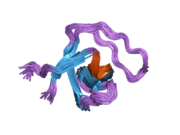SORBS3
Protein-coding gene in the species Homo sapiens
| SORBS3 | |||||||||||||||||||||||||||||||||||||||||||||||||||
|---|---|---|---|---|---|---|---|---|---|---|---|---|---|---|---|---|---|---|---|---|---|---|---|---|---|---|---|---|---|---|---|---|---|---|---|---|---|---|---|---|---|---|---|---|---|---|---|---|---|---|---|
 | |||||||||||||||||||||||||||||||||||||||||||||||||||
| |||||||||||||||||||||||||||||||||||||||||||||||||||
| Identifiers | |||||||||||||||||||||||||||||||||||||||||||||||||||
| Aliases | SORBS3, SCAM-1, SCAM1, SH3D4, sorbin and SH3 domain containing 3 | ||||||||||||||||||||||||||||||||||||||||||||||||||
| External IDs | OMIM: 610795; MGI: 700013; HomoloGene: 4218; GeneCards: SORBS3; OMA:SORBS3 - orthologs | ||||||||||||||||||||||||||||||||||||||||||||||||||
| |||||||||||||||||||||||||||||||||||||||||||||||||||
| |||||||||||||||||||||||||||||||||||||||||||||||||||
| |||||||||||||||||||||||||||||||||||||||||||||||||||
| |||||||||||||||||||||||||||||||||||||||||||||||||||
| |||||||||||||||||||||||||||||||||||||||||||||||||||
| Wikidata | |||||||||||||||||||||||||||||||||||||||||||||||||||
| |||||||||||||||||||||||||||||||||||||||||||||||||||
Vinexin is a protein that in humans is encoded by the SORBS3 gene.[5][6][7]
Interactions
SORBS3 has been shown to interact with DLG5[8] and MAPK1.[9]
References
- ^ a b c GRCh38: Ensembl release 89: ENSG00000120896 – Ensembl, May 2017
- ^ a b c GRCm38: Ensembl release 89: ENSMUSG00000022091 – Ensembl, May 2017
- ^ "Human PubMed Reference:". National Center for Biotechnology Information, U.S. National Library of Medicine.
- ^ "Mouse PubMed Reference:". National Center for Biotechnology Information, U.S. National Library of Medicine.
- ^ Kioka N, Sakata S, Kawauchi T, Amachi T, Akiyama SK, Okazaki K, Yaen C, Yamada KM, Aota S (Mar 1999). "Vinexin: a novel vinculin-binding protein with multiple SH3 domains enhances actin cytoskeletal organization". J Cell Biol. 144 (1): 59–69. doi:10.1083/jcb.144.1.59. PMC 2148117. PMID 9885244.
- ^ Kioka N (Jan 2003). "[A novel adaptor protein family regulating cytoskeletal organization and signal transduction--Vinexin, CAP/ponsin, ArgBP2]". Seikagaku. 74 (11): 1356–60. PMID 12510380.
- ^ "Entrez Gene: SORBS3 sorbin and SH3 domain containing 3".
- ^ Wakabayashi M, Ito Takuya, Mitsushima Masaru, Aizawa Sanae, Ueda Kazumitsu, Amachi Teruo, Kioka Noriyuki (Jun 2003). "Interaction of lp-dlg/KIAA0583, a membrane-associated guanylate kinase family protein, with vinexin and beta-catenin at sites of cell-cell contact". J. Biol. Chem. 278 (24): 21709–14. doi:10.1074/jbc.M211004200. ISSN 0021-9258. PMID 12657639.
- ^ Mitsushima M, Suwa Akira, Amachi Teruo, Ueda Kazumitsu, Kioka Noriyuki (Aug 2004). "Extracellular signal-regulated kinase activated by epidermal growth factor and cell adhesion interacts with and phosphorylates vinexin". J. Biol. Chem. 279 (33): 34570–7. doi:10.1074/jbc.M402304200. ISSN 0021-9258. PMID 15184391.
Further reading
- Akamatsu M, Aota S, Suwa A, et al. (2000). "Vinexin forms a signaling complex with Sos and modulates epidermal growth factor-induced c-Jun N-terminal kinase/stress-activated protein kinase activities". J. Biol. Chem. 274 (50): 35933–7. doi:10.1074/jbc.274.50.35933. PMID 10585480.
- Strausberg RL, Feingold EA, Grouse LH, et al. (2003). "Generation and initial analysis of more than 15,000 full-length human and mouse cDNA sequences". Proc. Natl. Acad. Sci. U.S.A. 99 (26): 16899–903. Bibcode:2002PNAS...9916899M. doi:10.1073/pnas.242603899. PMC 139241. PMID 12477932.
- Wakabayashi M, Ito T, Mitsushima M, et al. (2003). "Interaction of lp-dlg/KIAA0583, a membrane-associated guanylate kinase family protein, with vinexin and beta-catenin at sites of cell-cell contact". J. Biol. Chem. 278 (24): 21709–14. doi:10.1074/jbc.M211004200. PMID 12657639.
- Townson SM, Dobrzycka KM, Lee AV, et al. (2003). "SAFB2, a new scaffold attachment factor homolog and estrogen receptor corepressor". J. Biol. Chem. 278 (22): 20059–68. doi:10.1074/jbc.M212988200. PMID 12660241.
- Mitsushima M, Suwa A, Amachi T, et al. (2004). "Extracellular signal-regulated kinase activated by epidermal growth factor and cell adhesion interacts with and phosphorylates vinexin". J. Biol. Chem. 279 (33): 34570–7. doi:10.1074/jbc.M402304200. PMID 15184391.
- Martens N, Wery M, Wang P, et al. (2004). "The suppressor of cytokine signaling (SOCS)-7 interacts with the actin cytoskeleton through vinexin". Exp. Cell Res. 298 (1): 239–48. doi:10.1016/j.yexcr.2004.04.002. PMID 15242778.
- Beausoleil SA, Jedrychowski M, Schwartz D, et al. (2004). "Large-scale characterization of HeLa cell nuclear phosphoproteins". Proc. Natl. Acad. Sci. U.S.A. 101 (33): 12130–5. Bibcode:2004PNAS..10112130B. doi:10.1073/pnas.0404720101. PMC 514446. PMID 15302935.
- Gerhard DS, Wagner L, Feingold EA, et al. (2004). "The status, quality, and expansion of the NIH full-length cDNA project: the Mammalian Gene Collection (MGC)". Genome Res. 14 (10B): 2121–7. doi:10.1101/gr.2596504. PMC 528928. PMID 15489334.
- Bour G, Plassat JL, Bauer A, et al. (2005). "Vinexin beta interacts with the non-phosphorylated AF-1 domain of retinoid receptor gamma (RARgamma) and represses RARgamma-mediated transcription". J. Biol. Chem. 280 (17): 17027–37. doi:10.1074/jbc.M501344200. PMID 15734736.
- Rual JF, Venkatesan K, Hao T, et al. (2005). "Towards a proteome-scale map of the human protein-protein interaction network". Nature. 437 (7062): 1173–8. Bibcode:2005Natur.437.1173R. doi:10.1038/nature04209. PMID 16189514. S2CID 4427026.
- Mitsushima M, Ueda K, Kioka N (2006). "Vinexin beta regulates the phosphorylation of epidermal growth factor receptor on the cell surface". Genes Cells. 11 (9): 971–82. doi:10.1111/j.1365-2443.2006.00995.x. PMID 16923119. S2CID 24238810.
- Beausoleil SA, Villén J, Gerber SA, et al. (2006). "A probability-based approach for high-throughput protein phosphorylation analysis and site localization". Nat. Biotechnol. 24 (10): 1285–92. doi:10.1038/nbt1240. PMID 16964243. S2CID 14294292.
- Olsen JV, Blagoev B, Gnad F, et al. (2006). "Global, in vivo, and site-specific phosphorylation dynamics in signaling networks". Cell. 127 (3): 635–48. doi:10.1016/j.cell.2006.09.026. PMID 17081983. S2CID 7827573.
- Mizutani K, Ito H, Iwamoto I, et al. (2007). "Essential roles of ERK-mediated phosphorylation of vinexin in cell spreading, migration and anchorage-independent growth". Oncogene. 26 (50): 7122–31. doi:10.1038/sj.onc.1210512. hdl:20.500.12099/23093. PMID 17486060. S2CID 9284621.
External links
- SORBS3 human gene location in the UCSC Genome Browser.
- SORBS3 human gene details in the UCSC Genome Browser.
- v
- t
- e
PDB gallery
-
 2ct3: Solution Structure of the SH3 domain of the Vinexin protein
2ct3: Solution Structure of the SH3 domain of the Vinexin protein -
 2dlm: Solution structure of the first SH3 domain of human vinexin
2dlm: Solution structure of the first SH3 domain of human vinexin -
 2nwm: Solution structure of the first SH3 domain of human Vinexin and its interaction with the peptides from Vinculin
2nwm: Solution structure of the first SH3 domain of human Vinexin and its interaction with the peptides from Vinculin
 | This article on a gene on human chromosome 8 is a stub. You can help Wikipedia by expanding it. |
- v
- t
- e




















